Featured Article
Article Title
Mental Health Aftercare Availability for Juvenile Justice-Involved Youth in New York City
Authors
Tiffany Martin, MD - Resident Physician New York University Grossman School of Medicine, New York, NY
Nicolette Karim, BS - Child and Adolescent Psychiatry Fellowship Program Coordinator New York University Grossman School of Medicine, New York, NY
Eric Whitney, MD - Clinical Assistant Professor New York University Grossman School of Medicine, New York, NY
Tomika Carter, MSW - Executive Director of Bellevue Juvenile Justice Mental Health Services New York University Grossman School of Medicine, New York, NY
Radhika Mattoo, BA, MS - Senior Software Engineer New York University Grossman School of Medicine, New York, NY
Sarah Horwitz, PhD - Professor, New York University Grossman School of Medicine, New York, NYAbstract
The goal of our study was to describe the availability of community child and adolescent mental health services, trauma-informed care, and the geographic accessibility of these services for juvenile justice-involved (JJ) youth who received mental health services while in secure detention. Data collection occurred through direct contact with the child and adolescent outpatient clinics listed on the New York State Office of Mental Health website. Zip codes were collected from the juvenile secure detention census. Of the clinics contacted, 88.5 percent accepted JJ youth; however, 43.5 percent accepted them on a conditional basis. Only 62.1 percent offered trauma-informed care, including evidence-based interventions and unspecified care. Although 84.5 percent of the clinics that would accept this population reported currently accepting new patients, reported wait times were as high as six or more months. When JJ residents’ home zip codes and those of the clinics were geographically mapped, there were few clinics in the zip codes where most residents lived. The clinics that accepted youth on a conditional basis often refused high-risk patients, essentially ruling out a large majority of this population. The geographical inaccessibility of these clinics limits their ability to provide care for this vulnerable population.
Keywords
Child and adolescent psychiatry, Community psychiatry, Aftercare, Juvenile justice, Transitions of care
Summary of Research
“...One-third of incarcerated youth reported recent suicidal thoughts and one-tenth reported prior suicide attempts… When left untreated, these mental health disorders are likely to endure and even worsen, which may lead to further negative outcomes. … Youth who do not receive mental health services have higher rates of and reduced time to recidivism. Although referrals to mental health in this population have historically been low, engagement with these services improves success in reentry into the community…. The current data indicate that referrals to mental health care, during justice involvement and after release, improve outcomes” (p. 1).
“Although some facilities provide initial screening services for mental health disorders, suicide risk, and substance use, many of these programs are not staffed by mental health professionals. Additionally, many facilities are unable to offer psychotherapy or other mental health services outside of crisis management.… As a result, youth are often released without aftercare referrals or reentry programming and must seek services on their own. …When youth and their families have access to increased systemic coordination, referrals, and structured guidance, there is greater engagement with care. Although systematic coordination of care is a crucial component in the reentry process, success hinges on the availability and accessibility of reentry services” (p. 2).
“This study employed the methods described by Cervantes et al. in their 2022 study of mental health service availability for autistic youth in New York City. The New York State Office of Mental Health (NYSOMH) manages their own psychiatric centers and provides certification and oversight for over 4,500 mental health programs run by local government and nonprofits across the state… Utilizing this “Find a Mental Health Program” search tool30 on the NYSOMH website.... yielded 175 clinics across all five boroughs… using the complete census on February 1, 2023… Twelve clinics were deemed ineligible for the study and were excluded. These clinics were considered ineligible because they only served patients over the age of 18… were school based clinics…, or did not provide mental health services. After excluding the ineligible and unreachable clinics, 131 clinics were included in the study sample” (p. 2- 3).
“Clinics in Brooklyn and Queens were more likely to have conditional acceptances, and Staten Island only had two clinics represented on our list. The highest density zip codes often had only a single clinic within the area, and some had none. … Consistent with other descriptive accounts of poor service availability for this population, in this investigation, roughly one-fifth of NYSOMH-listed clinics were unreachable, with another nearly 7 percent not clinically appropriate. Only one-third of listed clinics stated they would accept JJ youth for evaluation and treatment without conditions…. many other clinics cited high risk as a catchall category that would prevent them from accepting JJ youth. In fact, many of the experiences that directly or indirectly lead youth to the juvenile detention system would place them in high risk categories, thus effectively excluding them from services” (p. 6).
“Although the increased prevalence of telehealth services presents a promising avenue for increasing access to care, this method of care delivery produces additional accessibility disparities for vulnerable populations. … Still, despite the high prevalence of trauma experienced by JJ youth, only about 60 percent of accepting or conditionally accepting clinics reported providing some form of trauma informed care…” (p. 7).
“This study is the first to quantify, characterize, and geographically locate the outpatient mental health aftercare services for JJ youth. Even in the highly resourced setting of New York City, the available outpatient mental health resources are neither sufficient nor easily accessible for JJ youth with mental health challenges after their release from detention… These data emphasize the need for further investment in high quality mental health resources for youth transitioning out of the juvenile justice system in and around the communities in which they reside” (p. 7).
Translating Research into Practice
Understanding Barriers:
“The literature on mental health treatment associated with the juvenile justice system is limited and generally focuses on treatment prior to or separate from arrest… In the community, JJ youth experience numerous barriers to accessing mental health services, including, but not limited to, scarcity of providers who accept JJ youth, long waiting lists, high costs, poor insurance coverage, mental health stigma, racial bias, onerous reentry paperwork, distrust of providers, lack of transportation, and lack of information provided by the justice system” (p. 1- 2).
Geographic Treatment/ Acceptance Limitations:
“More than 15 percent of clinics that would accept or conditionally accept JJ youth referrals were not accepting new patients at the time of this study. Access to these clinics requires both that they be accepting new patients and that referred patients can readily travel to appointments… Our geographical data highlight the additional structural barriers to aftercare many JJ youth face… Few clinics accept this population, fewer still have capacity for new patients, and a very limited number offer trauma-informed care of any kind. Those clinics that are available are often located a considerable distance from these youth who need care” (p. 7).
Other Interesting Tidbits for Researchers and Clinicians
“Continued mental health services after receiving care in juvenile justice facilities have been associated with increased success in pursuing education and employment” (p. 2).
Clinic Results:
- Trauma Informed Care:
“Of the clinics accepting or conditionally accepting JJ youth (n =116), 38 of the accepting (32.8%) and 34 of the conditionally accepting (29.3%) stated they offered trauma-informed care. Of the 38 accepting clinics, 36 responded that they had trauma informed care and only two spontaneously specified the evidence-based trauma therapy offered. Of the 34 conditionally accepting clinics, 32 responded they had trauma-informed care and only two specified the evidence-based trauma therapy offered. Twenty-one of the accepting clinics (18.1%) and 23 of the conditionally accepting clinics (19.8%) stated that they did not offer trauma-informed care” (p. 4).
- New Clients:
“Of the clinics accepting or conditionally accepting JJ youth (n = 116), 50 of the accepting clinics (43.1%) and 48 of the conditionally accepting clinics (41.4%) stated that they were accepting new patients. Nine of the accepting clinics (7.8%) and nine of the conditional clinics (7.8%) reported they were not taking new patients” (p. 4).
- Waitlist:
“For the accepting clinics (n =59), six either did not have a waitlist or were walk-in only, 11 offered a wait time of less than one month, 22 offered greater than one month, and 12 could not specify a wait time. For the conditionally accepting clinics (n =57), none had a waitlist or were walk-in only, eight offered await time of less than a month, 22 offered greater than one month, and 18 could not specify a wait time. Notably, the longest wait time offered by an accepting clinic was eight or more months and the longest by a conditionally accepting clinic was four or more months” (p. 4).
“..Despite the high prevalence of trauma experienced by JJ youth, only about 60 percent of accepting or conditionally accepting clinics reported providing some form of traumainformed care. These findings likely overstate the quality of treatment offered, as a much smaller fraction of clinics specifically cited evidence-based therapies that are the accepted standard of care” (p. 7).
Additional Resources/Programs
As always, please feel free to check out the resources below and comment to add more to the discussion!


























